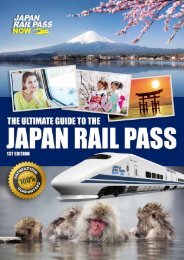Japan Rail Pass Now - Japan Travel Guide
Japan Travel Guide by Japan Rail Pass Now (www.japanrailpass.com.au)
Japan Travel Guide by Japan Rail Pass Now (www.japanrailpass.com.au)
You also want an ePaper? Increase the reach of your titles
YUMPU automatically turns print PDFs into web optimized ePapers that Google loves.
Nagasaki <strong>Travel</strong> <strong>Guide</strong><br />
Things To See<br />
Visit the Nagasaki Peace Park<br />
Built to commemorate the atomic bombing of the city during World War II, the Nagasaki<br />
Peace Park is home to several memorials and monuments that remember the destruction<br />
and victims of the tragedy. Its most notable attractions are the large Peace Statue, the<br />
Hypocenter Park (where a marked area of the epicentre of the explosion can be found)<br />
and the Nagasaki Atomic Bomb Museum.<br />
Go to Gunkanjima<br />
A 50-minute boat ride from Nagasaki Port, Gunkanjima is a tiny, abandoned island (150<br />
metres wide and 480 metres long) that used to be a coal mine up until 1974. A guided<br />
tour to the island is available daily, and lets guests see the deteriorated remains of<br />
buildings and other facilities.<br />
Confucius Shrine<br />
Stroll around the Glover Garden<br />
Home to mansions of Western merchants who settled in <strong>Japan</strong> in the late 1800s,<br />
Glover Garden is an open air exhibition of houses and residences that feature Western<br />
architecture with a touch of <strong>Japan</strong>ese influence. It has a spacious garden that offers<br />
panoramic views of the city and surroundings.<br />
Check out the city’s religious buildings and structures<br />
Glover garden<br />
Nagasaki is home to the Koshi-byo, a Confucius Shrine built in 1893 by the city’s Chinese<br />
residents; the Kofukuji, a Buddhist temple built in 1620 at the foot of a hill; and the Oura<br />
Tenshudo, a Catholic Church constructed in 1864 and the oldest surviving Christian place of worship in <strong>Japan</strong>.<br />
Attend the Nagasaki Kunchi<br />
The Nagasaki Kunchi Festival is an annual event that is held 7-9 October in Nagasaki. Observed by the city for about four centuries now, it is a unique<br />
festival that fuses Dutch and Chinese influences throughout Nagasaki’s history. It is highlighted by large floats and dragon dance performances.<br />
Where To Explore<br />
●<br />
●<br />
●<br />
Chinatown – The oldest Chinatown in <strong>Japan</strong>, Nagasaki Chinatown, or Shinchi Chinatown, was founded in the 17th century by Chinese<br />
merchants. Today, its many restaurants and eateries offer a wide selection of noodle dishes, particularly sara udon and champon, and<br />
attract local and foreign tourists all year round.<br />
Dejima – Built in 1636 for the Portuguese people living in Nagasaki, Dejima is an historic area that features remnants of old walls, gates,<br />
residences and warehouses.<br />
Mount Inasa – Standing at 333 metres high, Mount Inasa is located close to central Nagasaki and offers stunning views of the city at<br />
night. Its summit and observatory can be reached by car, bus or ropeway.<br />
Getting Around<br />
Nagasaki has four tram lines that link all of its main sightseeing attractions. A ride costs 120 yen, and a one-day pass is also available for 500 yen.<br />
Many of Nagasaki’s top attractions are located close to each other, so walking is also a good and healthy way of exploring the city.<br />
108 - <strong>Japan</strong> <strong>Travel</strong> <strong>Guide</strong>



